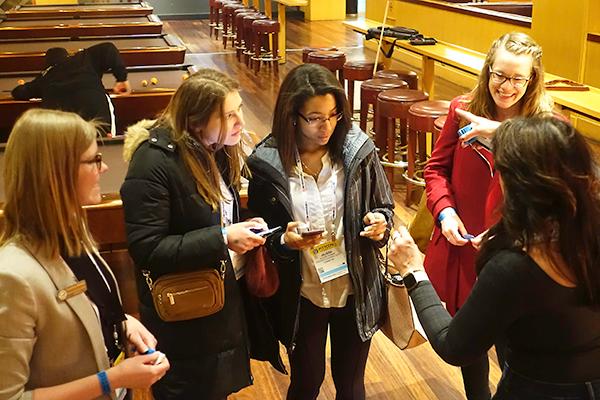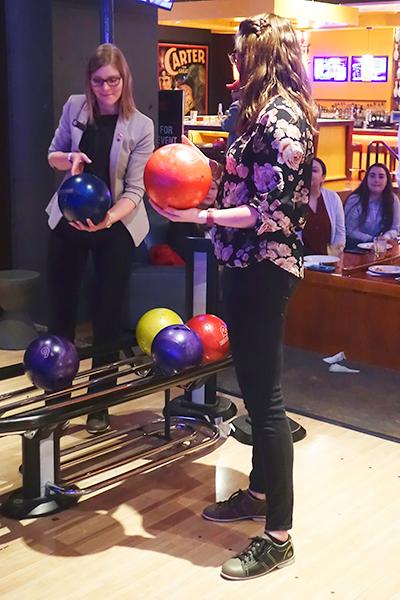May 2020
 |
Editor's Note: Spectroscopy in the Midst of COVID-19
We are continuing to gather stories from our membership and readers as to how they are managing to still do applied spectroscopy in the midst of state-level shutdowns/stay-at-home orders. Shorter stories and photo stories will be shared via our Social Media means (LinkedIn, Facebook,Twitter) in addition to appearing here in the Newsletter. Please submit your story directly to the SAS Newsletter Editor, Luisa Profeta at luisaprofeta@gmail.com.
|
 Pittcon 2020 Recap Pittcon 2020 Recap
Considering the screeching halt of society as of the time of this writing (mid-March), by the skin of its teeth, Pittcon 2020 just escaped cancellation as several other relevant scientific meetings did during and after the first week of March. The American Chemical Society Spring meeting, the APS Physics meeting, SPIE Defense and Commercial Sensing and the Spring SciX meeting in the UK are just a few of the prominent meetings outright cancelled. Few Pittcon attendees were shocked that many vendors (at least 12 that I could count) were absent in the face of travel restrictions by both companies and governments alike.
Pittcon 2020 was held in Chicago, Illinois, from 29 February-5 March 2020, with the meeting planning to rotate back to New Orleans, Louisiana, for 2021. The conference exposition went from Tuesday-Thursday as it had done in 2019. SAS's Educational outreach to the community began on Saturday and lasted through Tuesday, with six different short courses taught by SAS members. These courses drew over 40 attendees, with 14 of those attendees taking two or more classes. Attendees representing industry, academia, government, and national labs were present from five different countries. The courses were:
- Practical Vibrational Spectroscopy
- Spectral Searching
- Problems with FT-IR Spectra and How to Avoid Them
- Introduction to Raman spectroscopy and Imaging
- Process Analytical Technology: Out of the Lab and Into the Line
- Modern Portable Analytical Spectroscopy
Sunday evening the Executive Committee (EC) meeting took place, where several awards were voted on and approved. At the time of this writing, the award letters have just been sent out to those awardees, so look for more information regarding these awardees in a future SAS Newsletter. The Early Career Committee also detailed more about their future work and outreach to the SAS Early Career membership during the EC, so details of those actions will be fleshed out in a future SAS Newsletter too.
Monday evening, the annual SAS Student event at Pittcon took place at the Lucky Strike not far from the McCormick place. Drinks, snacks, bowling, and socializing was enjoyed by all after Monday's busy technical schedule, including one of the two symposia SAS organized this year for Pittcon (see next section for more details). To my knowledge, none of the students figured out the angular momentum of the bowling balls as they were thrown down the lanes, however it was suspected that the lane's coefficient of friction was also higher than preferred for a 300 game.
 |
 |
| Students at the Lucky Strike SAS student event. |
Preparing to roll a strike at the student event. |
A positive aspect of being in a scientifically aware community is the proactive approach vendors and attendees alike took in preserving health and social distancing, including alternative forms of greeting such as elbow bumps, foot taps, or the classic Vulcan salutation; hand sanitizers as free giveaways; and discussions of how to best support one another in the looming quarantine state caused by COVID-19. The SAS community may not reconvene together in person until SciX 2020; fingers crossed that COVID-19 does not intensify in the autumn months much like the Spanish Flu of 1918! Thankfully, technology allows for continued colleague collaboration via teleconferences, video conferences and webinars during this time of isolation in an effort to stop the spread of COVID-19.
Luisa T.M. Profeta
SAS Newsletter Editor
luisaprofeta@gmail.com
|
SAS Symposia at Pittcon 2020
|
 From left: Brian Cunningham, Olivier Burggraaff, Aldo Roda, Richard Crocombe (SAS President 2020), David Erickson, and Russ Algar. Photo by Luisa Profeta, SAS. From left: Brian Cunningham, Olivier Burggraaff, Aldo Roda, Richard Crocombe (SAS President 2020), David Erickson, and Russ Algar. Photo by Luisa Profeta, SAS.
|
SAS organized two symposia this year at Pittcon. The first, on the Monday of the Conference, was entitled, "Smartphone Spectroscopy for Analyses and assays in Low Resource Areas and had an international speaker panel. The first speaker, Olivier Burggraaff (Leiden University, the Netherlands, "A Smartphone Add-On for Spectrometry and Polarimetry) described how to obtain quality scientific data using a smartphone camera, and then how, by equipping thousands of citizens with a low-cost smartphone attachment, how "citizen science studies can be conducted. Russ Algar (The University of British Columbia, Canada, "The Right Tool for the Job: Optimum Fluorescent Materials for Smartphone-Based Bioanalysis) described how as semiconductor quantum dots (QDs) and semiconducting polymer dots (Pdots), have superior fluorescence properties that address many of these shortcomings of smartphone cameras, and enable new possibilities. Aldo Roda (University of Bologna, Italy, "Chemical Luminescence-Based Smartphone Biosensor: A Simple Tool for Portable Diagnostics in Developing Countries) discussed chemical luminescence-based probes in which photon emission is triggered by a dark chemical reaction, and how these can address point-of-need requirements. Brian Cunningham (University of Illinois, "Compact Spectroscopy for Quantitative Analysis of Colorimetric Assays at the Point of Care) outlined their development of a battery-operated, handheld instrument and assay approach that automates performing an enzyme-linked immunosorbent assay (ELISA) in a single step. In addition, he described a novel optical component called a single layer linear variable filter (SL-LVF) that enables a photodetector array chip to capture kinetic colorimetric absorption spectra "movies from multiple microfluidic lanes within the cartridge. The last talk in this symposium was given by David Erickson (Cornell University, "Optically Based Point-of-Care Diagnostic Technologies for Infectious Diseases and Nutritional Deficiencies). He discussed some of the technologies and approaches to enable point-of-care diagnostics for vitamin and micronutrient deficiencies, and infectious disease related cancers like Kaposi's Sarcoma. The device they have developed the tiny isothermal nucleic acid quantification system, or TINY, has shown promise as a point-of-care detector of Kaposi sarcoma-associated herpes virus (KSHV) in resource-limited settings such as sub-Saharan Africa, notably during field trails in Uganda.
|
 From left: Mary Kate Donais, Ellen Miseo, Pauline Leary, Richard Crocombe, Suzanne Schreyer, Amy Bauer, Katherine Bakeev. Photo by Luisa Profeta, SAS. From left: Mary Kate Donais, Ellen Miseo, Pauline Leary, Richard Crocombe, Suzanne Schreyer, Amy Bauer, Katherine Bakeev. Photo by Luisa Profeta, SAS.
|
The second symposium, on the Tuesday of the Conference, was entitled "Portable Spectroscopy in 2020. In contrast to the first Symposium (all university, all male), the second was all instrumentation and all female. The session also featured three former SAS Presidents: Mary Kate Donais (Symposium Chair, St. Anselm College, New Hampshire) with Ellen Miseo (Teak Origin) and Katherine Bakeev (B&WTek) as invited speakers. The first speaker was Pauline Leary (Federal Resources, "The Value of Portable Mass Spectrometry and Gas Chromatography-Mass Spectrometry), and she described the applications and limitations of these devices, "high pressure mass spectrometers and fully integrated GC-MS instruments. These are mostly used within the environmental, first responder, and military communities, to detect and identify trace levels of hazardous and dangerous chemicals in the field. Amy Bauer (Ocean Insights, "Analytical 'Guns': Handheld XRF and LIBS, a Comparison) provided a comparison of the capabilities of the mature handheld X-ray fluorescence (XRF) instruments and the much more recently introduced (and still developing) handheld laser-induced breakdown spectroscopy (LIBS) instruments. In particular, HH LIBS instruments address applications for light elements that HH XRF cannot perform. Katherine Bakeev discussed handheld Raman instruments, in the context of advances in instrumentation allowing smaller instruments, fluorescence mitigation and through-package sampling, with an additional emphasis on converting spectra to specific information for the operator. Suzanne Schreyer (Rigaku Analytical Devices, "Library and Method Development: What Lies Behind the Black Box?) discussed the chemometric software used on handheld instruments to convert that data into information, with examples of the approaches required to develop robust models for both identification (library building) and also quantitative analysis. Finally, Ellen Miseo (Teak Origin, "Portable Near Infrared in Food Analysis—What Exists and Does It Work?) described the performance of some handheld visible and near-infrared spectrometers, some of which are being pitched at the general public almost as "magic analyzers. Unfortunately the lowest cost devices, aimed directly at the general public, have poor and/or irreproducible performance; while those produced by conventional instrument and optics companies, while more expensive (but in this spectral region, still only about $2000), have respectable performance and could be used in analysis of produce for their major components.
Contributed by Richard Crocombe
2020 SAS President
racrocombe@gmail.com
|
The Annual Election of SAS Officer and Governing
Board Delegates will be held electronically from
May 18-June 26, 2020.
All regular, non-student members in good standing are eligible to vote
and will receive an email with voting instructions and login information
from our online election provider Elections Online. Please check your spam
folders for this email. If you do not receive it by opening day of the election
contact the SAS office at sasadmin@s-a-s.org or 301-694-8122.
Click here for SAS Candidate Profiles
|
|
Do you have something spectroscopy-related you want to discuss in the newsletter? Or something that will help our membership such as career tips or application tips? Please let us know by emailing luisaprofeta@gmail.com.
|
© 2020 Society for Applied Spectroscopy | Telephone: 301-694-8122 | FAX: 301-694-6860
|
|